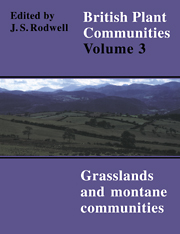Book contents
- Frontmatter
- Contents
- List of Figures
- Preface and Acknowledgements
- Preamble
- Mesotrophic Grasslands
- Community Descriptions
- Calcicolous Grasslands
- Community Descriptions
- Calcifugous Grasslands and Montane Communities
- Community Descriptions
- Index of Synonyms to Grasslands and Montane Communities
- Index of Species in Grasslands and Montane Communities
- Bibliography
Introduction to Calcicolous Grasslands
Published online by Cambridge University Press: 04 July 2020
- Frontmatter
- Contents
- List of Figures
- Preface and Acknowledgements
- Preamble
- Mesotrophic Grasslands
- Community Descriptions
- Calcicolous Grasslands
- Community Descriptions
- Calcifugous Grasslands and Montane Communities
- Community Descriptions
- Index of Synonyms to Grasslands and Montane Communities
- Index of Species in Grasslands and Montane Communities
- Bibliography
Summary
The sampling of calcicolous grasslands
Grasslands in which calcicoles are a prominent feature have long attracted attention among British ecologists. Some of these swards were the subject of classic, early descriptions of our vegetation (Moss 1907, 1911, 1913, Tansley & Rankin 1911, Tansley & Adamson 1925, 1926) and the behaviour of plants in what are often rich and delightful assemblages has proved an abiding fascination. Huge losses among these grasslands and their continuing vulnerability to either agricultural improvement or neglect have also greatly enhanced the nature conservation interest of surviving stands. The contribution of these swards to impressive open landscapes with their associations of settled pastoralism is much valued, too: the more so with the proximity of many tracts to centres of dense population like the south-east of England. Yet, in some ways, these very qualities have hindered the development of a universally accepted classification of calcicolous grasslands.
For one thing, much scientific study has been preoccupied with particular regions or sites. This has been enormously informative about the relationships between their different swards and the subtle interplay of climatic factors, soil conditions and treatment history which have influenced them in those particular localities. At the same time, the very wealth of detail has been difficult to accommodate within a balanced overview of floristic variation among all these grasslands and its relation to broader environmental trends. Rather, there has grown up a series of regional perspectives from, for example, the southern English Chalk, the Peak District, Upper Teesdale and the Breadalbane Mountains, each viewpoint acquiring some sort of determinative authority for interpreting the rest. From the start of this survey, we were resolved to sample as widely as possible among these grasslands so as to set local insights within a general framework of understanding and to test the status of accepted distinctions between vegetation types that sometimes seemed to owe too much to particular enthusiasms.
Closely associated with the commitment to understanding and safeguarding the swards of particular localities, there has developed from the earliest days a persistent habit of speaking about ‘Chalk grassland’, ‘Carboniferous Limestone grassland’ and so on, as if the nature of the bedrock were the controlling factor in determining the character of the vegetation and the best basis for classifying it. We did not ourselves wish to begin with this assumption and our sampling of these grasslands was part of the much wider survey of vegetation, on and off Chalk, other kinds of limestone and calcareous superficials throughout the country.
- Type
- Chapter
- Information
- British Plant Communities , pp. 107 - 116Publisher: Cambridge University PressPrint publication year: 1992



